Connect With Us
Blog
Items filtered by date: March 2023
Overpronation From Flat Feet
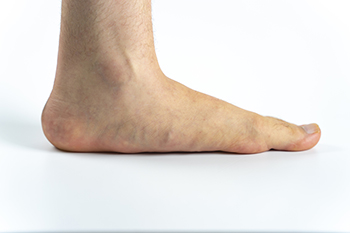
Overpronation is when the arch of the foot collapses and the foot and ankle roll inward when walking. Medically, this is called pes planus, flexible flatfoot, or more commonly, flat feet. Those who overpronate can be at risk for more injuries than others. Children are born with flat feet, but arches typically develop in the teenage years. Overpronation can occur when the arches are overly flexible, and it can be caused by obesity or pregnancy, inflammation or damage to the tendon, or arthritis in the foot, among other things. Walking or standing can be uncomfortable for those who overpronate. Relief can be found by wearing more supportive shoes, using orthotics, and maintaining a normal body weight. If you have ongoing foot pain, it is suggested that you make an appointment with a podiatrist for a proper diagnosis and treatment plan.
Flatfoot is a condition many people suffer from. If you have flat feet, contact one of our podiatrists from Foot & Ankle Associates of Maine. Our doctors will treat your foot and ankle needs.
What Are Flat Feet?
Flatfoot is a condition in which the arch of the foot is depressed and the sole of the foot is almost completely in contact with the ground. About 20-30% of the population generally has flat feet because their arches never formed during growth.
Conditions & Problems:
Having flat feet makes it difficult to run or walk because of the stress placed on the ankles.
Alignment – The general alignment of your legs can be disrupted, because the ankles move inward which can cause major discomfort.
Knees – If you have complications with your knees, flat feet can be a contributor to arthritis in that area.
Symptoms
- Pain around the heel or arch area
- Trouble standing on the tip toe
- Swelling around the inside of the ankle
- Flat look to one or both feet
- Having your shoes feel uneven when worn
Treatment
If you are experiencing pain and stress on the foot you may weaken the posterior tibial tendon, which runs around the inside of the ankle.
If you have any questions please feel free to contact our office located in Brunswick, ME . We offer the newest diagnostic and treatment technologies for all your foot and ankle needs.
How Supination Can Affect Your Health
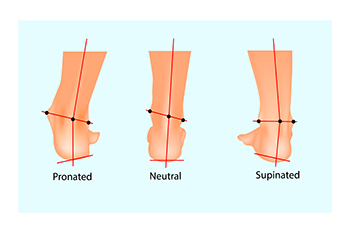
The way you walk can affect the health of your feet and other parts of the body. If your foot rolls outward when you walk it puts extra pressure on the outside of the feet. This action is termed supination, and it can induce pain as well as increase the chance of injury. Supination is thought to be caused by having a high arch and can be worsened if your footwear does not offer the proper support. Pain from supination can be felt in the feet, ankles, knees, hips, and lower back. It also increases the chances of sprains, strains, and shin splints. It has been found that certain orthotics can help to overcome this gait abnormality. Features that can help reduce the pain include arch support to keep the foot from rolling outward, a deep heel cup to help stabilize the heel, and extra cushioning for the foot. It is suggested that you consult a podiatrist who can examine your feet and create custom orthotics that will help counteract the problems of supination.
If you have any concerns about your feet, contact one of our podiatrists from Foot & Ankle Associates of Maine. Our doctors can provide the care you need to keep you pain-free and on your feet.
Biomechanics in Podiatry
Podiatric biomechanics is a particular sector of specialty podiatry with licensed practitioners who are trained to diagnose and treat conditions affecting the foot, ankle and lower leg. Biomechanics deals with the forces that act against the body, causing an interference with the biological structures. It focuses on the movement of the ankle, the foot and the forces that interact with them.
A History of Biomechanics
- Biomechanics dates back to the BC era in Egypt where evidence of professional foot care has been recorded.
- In 1974, biomechanics gained a higher profile from the studies of Merton Root, who claimed that by changing or controlling the forces between the ankle and the foot, corrections or conditions could be implemented to gain strength and coordination in the area.
Modern technological improvements are based on past theories and therapeutic processes that provide a better understanding of podiatric concepts for biomechanics. Computers can provide accurate information about the forces and patterns of the feet and lower legs.
Understanding biomechanics of the feet can help improve and eliminate pain, stopping further stress to the foot.
If you have any questions please feel free to contact our office located in Brunswick, ME . We offer the newest diagnostic and treatment technologies for all your foot and ankle needs.
Are You Suffering From Ingrown Toenails?
Stretches May Provide Relief From Heel Spurs
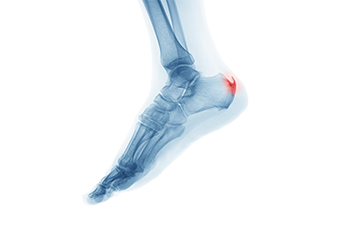
Heel spurs are often uncomfortable, and patients may benefit from performing certain types of stretches and exercises. These may help to lengthen the plantar fascia, which can reduce stress on the heel. Calf stretches can be effective in finding relief from heel spurs. This is done by standing on a step and lowering one heel at a time until a gentle stretch is felt. The foot can be slowly rocked back and forth, which can help loosen the plantar fascia. An additional stretch for plantar fascia is done by sitting on the floor with the affected foot crossed over the opposite knee. This is followed by taking a towel or similar object, wrapping it around the sole of the foot, and stretching the foot towards the body. Heel spurs may be prevented by wearing shoes that fit correctly and by limiting time walking and standing on hard surfaces. If you have a heel spur, it is strongly suggested that you are under the care of a podiatrist who can guide you toward proper treatment and prevention methods.
Heel spurs can be incredibly painful and sometimes may make you unable to participate in physical activities. To get medical care for your heel spurs, contact one of our podiatrists from Foot & Ankle Associates of Maine. Our doctors will do everything possible to treat your condition.
Heels Spurs
Heel spurs are formed by calcium deposits on the back of the foot where the heel is. This can also be caused by small fragments of bone breaking off one section of the foot, attaching onto the back of the foot. Heel spurs can also be bone growth on the back of the foot and may grow in the direction of the arch of the foot.
Older individuals usually suffer from heel spurs and pain sometimes intensifies with age. One of the main condition's spurs are related to is plantar fasciitis.
Pain
The pain associated with spurs is often because of weight placed on the feet. When someone is walking, their entire weight is concentrated on the feet. Bone spurs then have the tendency to affect other bones and tissues around the foot. As the pain continues, the feet will become tender and sensitive over time.
Treatments
There are many ways to treat heel spurs. If one is suffering from heel spurs in conjunction with pain, there are several methods for healing. Medication, surgery, and herbal care are some options.
If you have any questions feel free to contact our office located in Brunswick, ME . We offer the latest in diagnostic and treatment technology to meet your needs.
Symptoms of Morton’s Neuroma

The pain from the foot condition which is known as Morton’s neuroma is felt in the ball of the foot. Patients notice the sensation can feel like a pebble is in the shoe or sock and can be uncomfortable. A common reason why Morton’s neuroma may develop can be from frequently wearing high heels. The small narrow toe box generally does not provide adequate room for the toes to move freely and can cause the nerve that lies between the third and fourth toes to become compressed and irritated. People who participate in sports such as tennis, running, and racquetball also may be prone to developing this condition. In severe cases, there may be a tingling or numbing sensation under the toes, and a burning feeling may radiate to the ball of the foot. An MRI may be suggested, and this is often helpful in ruling out an existing lesion. If you have symptoms of Morton’s neuroma, it is suggested that you contact a podiatrist as quickly as possible who can help you with relief and treatment methods.
Morton’s neuroma is a very uncomfortable condition to live with. If you think you have Morton’s neuroma, contact one of our podiatrists of Foot & Ankle Associates of Maine. Our doctors will attend to all of your foot care needs and answer any of your related questions.
Morton’s Neuroma
Morton's neuroma is a painful foot condition that commonly affects the areas between the second and third or third and fourth toe, although other areas of the foot are also susceptible. Morton’s neuroma is caused by an inflamed nerve in the foot that is being squeezed and aggravated by surrounding bones.
What Increases the Chances of Having Morton’s Neuroma?
- Ill-fitting high heels or shoes that add pressure to the toe or foot
- Jogging, running or any sport that involves constant impact to the foot
- Flat feet, bunions, and any other foot deformities
Morton’s neuroma is a very treatable condition. Orthotics and shoe inserts can often be used to alleviate the pain on the forefront of the feet. In more severe cases, corticosteroids can also be prescribed. In order to figure out the best treatment for your neuroma, it’s recommended to seek the care of a podiatrist who can diagnose your condition and provide different treatment options.
If you have any questions, please feel free to contact our office located in Brunswick, ME . We offer the newest diagnostic and treatment technologies for all your foot care needs.
Preventing Falls in the Grocery Store

When a senior grows older, it is common for the strength in their feet to be diminished. As a result, they might be likely to fall due to this diminished strength, which might, in turn, further injure the feet. The grocery store is one such place in which a senior might be particularly susceptible to suffering a fall. For example, there might be fluids on the floor that could prove to be especially slippery. Also, it is possible that items and products might have fallen from the shelves, creating tripping hazards for seniors. It can be important to do all you can to prevent falling in the grocery store to protect your feet from injury. One important way to do this is to improve mobility and strength in the feet. If you are a senior, you might contact a podiatrist today for more information on how you can prevent falls and to receive treatment for any foot condition you might have.
Preventing falls among the elderly is very important. If you are older and have fallen or fear that you are prone to falling, consult with one of our podiatrists from Foot & Ankle Associates of Maine. Our doctors will assess your condition and provide you with quality advice and care.
Every 11 seconds, an elderly American is being treated in an emergency room for a fall related injury. Falls are the leading cause of head and hip injuries for those 65 and older. Due to decreases in strength, balance, senses, and lack of awareness, elderly persons are very susceptible to falling. Thankfully, there are a number of things older persons can do to prevent falls.
How to Prevent Falls
Some effective methods that older persons can do to prevent falls include:
- Enrolling in strength and balance exercise program to increase balance and strength
- Periodically having your sight and hearing checked
- Discuss any medications you have with a doctor to see if it increases the risk of falling
- Clearing the house of falling hazards and installing devices like grab bars and railings
- Utilizing a walker or cane
- Wearing shoes that provide good support and cushioning
- Talking to family members about falling and increasing awareness
Falling can be a traumatic and embarrassing experience for elderly persons; this can make them less willing to leave the house, and less willing to talk to someone about their fears of falling. Doing such things, however, will increase the likelihood of tripping or losing one’s balance. Knowing the causes of falling and how to prevent them is the best way to mitigate the risk of serious injury.
If you have any questions, please feel free to contact our office located in Brunswick, ME . We offer the newest diagnostic and treatment technologies for all your foot care needs.
Burning Foot Pain and What It Can Mean
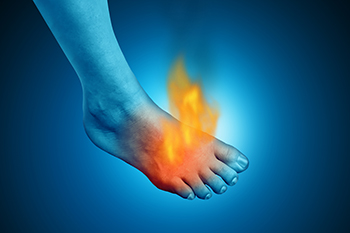
Many people experience the feeling of burning foot pain, which can interrupt both their daily activities and their sleep. But what does it mean? Major causes of burning foot pain include peripheral neuropathy, tarsal tunnel syndrome, plantar fasciitis, and Raynaud’s disease. People with high blood sugar may be especially at risk for peripheral neuropathy. This is a nerve condition that blocks normal communication between the brain and the nerves in your feet. Tarsal tunnel syndrome occurs when the posterior tibial nerve in the ankle is compressed, resulting in burning pain. Plantar fasciitis, which is the tearing and inflammation of the band of tissue under the foot, causes both heel and burning foot pain. Raynaud’s disease is caused when the blood vessels in the lower extremities are constricted. This limits blood flow to the feet and may result in burning foot pain. If burning foot pain becomes a regular occurrence, you may wish to consult a podiatrist who can help to determine the cause and offer treatment solutions.
Foot Pain
Foot pain can be extremely painful and debilitating. If you have a foot pain, consult with one of our podiatrists from Foot & Ankle Associates of Maine. Our doctors will assess your condition and provide you with quality foot and ankle treatment.
Causes
Foot pain is a very broad condition that could be caused by one or more ailments. The most common include:
- Bunions
- Hammertoes
- Plantar Fasciitis
- Bone Spurs
- Corns
- Tarsal Tunnel Syndrome
- Ingrown Toenails
- Arthritis (such as Gout, Rheumatoid, and Osteoarthritis)
- Flat Feet
- Injury (from stress fractures, broken toe, foot, ankle, Achilles tendon ruptures, and sprains)
- And more
Diagnosis
To figure out the cause of foot pain, podiatrists utilize several different methods. This can range from simple visual inspections and sensation tests to X-rays and MRI scans. Prior medical history, family medical history, and any recent physical traumatic events will all be taken into consideration for a proper diagnosis.
Treatment
Treatment depends upon the cause of the foot pain. Whether it is resting, staying off the foot, or having surgery; podiatrists have a number of treatment options available for foot pain.
If you have any questions, please feel free to contact our office located in Brunswick, ME . We offer the newest diagnostic and treatment technologies for all your foot care needs.
Neuropathy and Checking the Feet
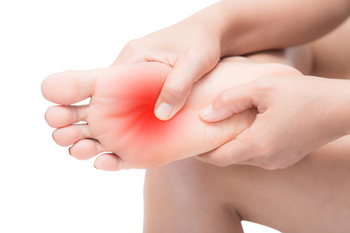
Another name for neuropathy is nerve damage. Common symptoms that neuropathy causes are total numbness or a tingling sensation in the feet. The feet may also turn blue and feel cold. This is a condition that is prevalent among diabetic patients, and the lack of feeling on the soles of the feet calls for a need to check the feet daily for cuts that may have developed. Patients who have chronic alcoholism may be at an increased risk for developing this condition, in addition to people who have a vitamin B12 deficiency. Neuropathy falls into three categories, consisting of mono, poly, and distal symmetric polyneuropathy. The former is generally caused by an injury, and affects one nerve. Multiple nerves are affected in patients who have polyneuropathy, and may create blood pressure or gastrointestinal symptoms. The latter may be more prevalent among people who have diabetes, and the upper extremities may become affected. If your feet are numb, it is strongly suggested that you are under the care of a podiatrist who can accurately diagnose and treat neuropathy.
Neuropathy
Neuropathy can be a potentially serious condition, especially if it is left undiagnosed. If you have any concerns that you may be experiencing nerve loss in your feet, consult with one of our podiatrists from Foot & Ankle Associates of Maine. Our doctors will assess your condition and provide you with quality foot and ankle treatment for neuropathy.
What Is Neuropathy?
Neuropathy is a condition that leads to damage to the nerves in the body. Peripheral neuropathy, or neuropathy that affects your peripheral nervous system, usually occurs in the feet. Neuropathy can be triggered by a number of different causes. Such causes include diabetes, infections, cancers, disorders, and toxic substances.
Symptoms of Neuropathy Include:
- Numbness
- Sensation loss
- Prickling and tingling sensations
- Throbbing, freezing, burning pains
- Muscle weakness
Those with diabetes are at serious risk due to being unable to feel an ulcer on their feet. Diabetics usually also suffer from poor blood circulation. This can lead to the wound not healing, infections occurring, and the limb may have to be amputated.
Treatment
To treat neuropathy in the foot, podiatrists will first diagnose the cause of the neuropathy. Figuring out the underlying cause of the neuropathy will allow the podiatrist to prescribe the best treatment, whether it be caused by diabetes, toxic substance exposure, infection, etc. If the nerve has not died, then it’s possible that sensation may be able to return to the foot.
Pain medication may be issued for pain. Electrical nerve stimulation can be used to stimulate nerves. If the neuropathy is caused from pressure on the nerves, then surgery may be necessary.
If you have any questions, please feel free to contact our office located in Brunswick, ME . We offer the newest diagnostic and treatment technologies for all your foot care needs.
Why Live with Pain and Numbness in Your Feet?
How Bunions Can Affect Runners

Bunions can be particularly difficult for runners to deal with, as the big toe absorbs a great deal of force with every step taken. Luckily, there are a few measures that a runner with bunions can practice to reduce the effect of having this toe deformity. A bunion develops when the bottom of the big toe juts outward and the top of the big toe is pushed inward toward the other toes. This shift in bone structure then affects other parts of the foot and can lead to metatarsal pain in the ball of the foot, blisters, corns, and other painful foot or toe problems. Rest, orthotics, and ice are some ways to alleviate the pain of runners with bunions. But bunion surgery is often the last resort. Recovery time can be up to three months, and wearing protective boots or some type of cast is often recommended. A podiatrist can offer a realistic time frame for recovery from bunion surgery and recommend a plan for getting back to running. If your bunions are making running more and more painful, please consult a podiatrist for treatment options.
If you are suffering from bunion pain, contact one of our podiatrists of Foot & Ankle Associates of Maine. Our doctors can provide the care you need to keep you pain-free and on your feet.
What Is a Bunion?
Bunions are painful bony bumps that usually develop on the inside of the foot at the joint of the big toe. As the deformity increases over time, it may become painful to walk and wear shoes. Women are more likely to exacerbate existing bunions since they often wear tight, narrow shoes that shift their toes together. Bunion pain can be relieved by wearing wider shoes with enough room for the toes.
Causes
- Genetics – some people inherit feet that are more prone to bunion development
- Inflammatory Conditions - rheumatoid arthritis and polio may cause bunion development
Symptoms
- Redness and inflammation
- Pain and tenderness
- Callus or corns on the bump
- Restricted motion in the big toe
In order to diagnose your bunion, your podiatrist may ask about your medical history, symptoms, and general health. Your doctor might also order an x-ray to take a closer look at your feet. Nonsurgical treatment options include orthotics, padding, icing, changes in footwear, and medication. If nonsurgical treatments don’t alleviate your bunion pain, surgery may be necessary.
If you have any questions, please feel free to contact our office located in Brunswick, ME . We offer the newest diagnostic and treatment technologies for all your foot care needs.


